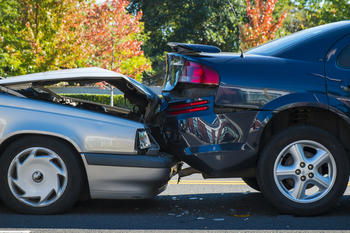Traversing any crowded, busy roadway brings myriad safety risks and demands on a driver’s attention. And even the most careful of drivers can’t control those driving around them, particularly the ones creeping up from behind.

“Don’t you dread the sound of screeching brakes from the car behind you, as you brace for the impact?” asked Emma Devine, a George Mason University systems engineering and operations research student who was part of a team—appropriately named “UR 2 Close”—that won two contests and finished second in another for their work on investigating rear-end collisions.
Devine and teammates Amanda Dalagan and Aidan Menon took first place in the public engagement track at the Costello College of Business Patriot Pitch Competition and in the general engineering track at the General Donald R. Keith Memorial Capstone Conference at West Point. Solutions are sorely needed, as rear-end collisions account for nearly one-third of all automobile accidents each year, resulting in thousands of deaths.
“We conducted a detailed analysis of crash data and found that most rear-end collisions occur on straight segments on highways, in good weather conditions, and in the late afternoons and evenings. This was a surprise,” said Dalagan.
The team’s solution is a license plate visual indicator. “There is presently no product designed to help drivers maintain safe following distances," Menon said. "There are heads-up displays and automated braking systems; those work to make sure you don't rear-end someone but do not protect you from being rear-ended. We thought a defensive approach would separate us from the pack.”
The team developed a simulation of vehicle dynamics during braking and accounted for driver reaction time, braking efficiency, and road conditions, concluding that following distance was a key criterion resulting in a rear-end accident. Observing a local road revealed only 20% of vehicles maintained a safe following distance.

“The Virginia Commonwealth Driver Regulations requires drivers to maintain a two-to-three second separation. But humans can't see time,” said Devine. “The solution to preventing rear-end collisions is to provide the following driver a clear indication of a safe following distance.”
Earlier this year the National Highway Traffic Safety Administration finalized a new standard mandating automatic emergency braking technology for all passenger cars and light trucks by September 2029, which will no doubt further help with such collisions.
“It was a privilege to sponsor this student team,” said Skip West, founder and CEO of Maxsa Innovations, a company that markets automotive products. “This project really emphasized the importance of systems engineering in doing analysis to understand the real problem before spending time and money developing a solution that may not work. These accidents are an important societal problem that we need to address, and this team has made a great start.”
